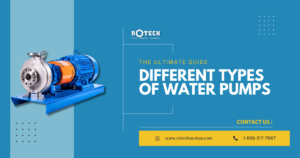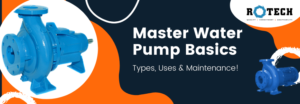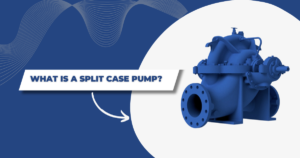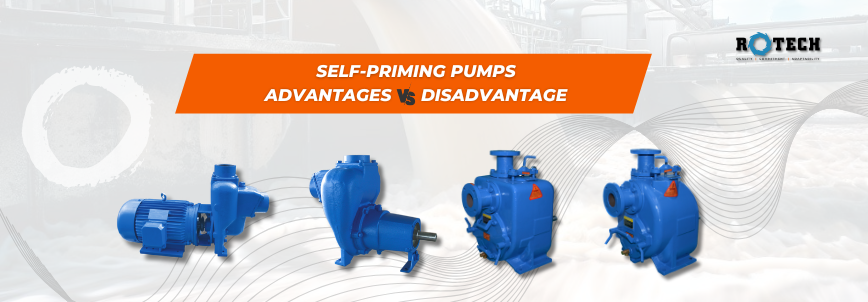When it comes to fluid transport and management, self-priming pumps have emerged as a beacon of innovation. These pumps offer a wide array of advantages that streamline operations, yet they are not without their drawbacks. In this in-depth exploration, we dive into the realm of self-priming pumps, uncovering their benefits, limitations, real-world applications, and the exciting future they hold.
Advantages of Self-Priming Pumps
A. Elimination of Manual Priming
- Explanation of Manual Priming Process: Picture this: a conventional pump sputters to life, but only after you’ve manually poured liquid into it. It’s a tedious process that’s both time-consuming and labour-intensive.
- How Self-Priming Pumps Automate Priming: Self-priming pumps, on the other hand, are like automated maestros. Their design includes a sophisticated mechanism that evacuates air and gases from the suction line, obviating the need for manual priming. The result? Instant and hassle-free pump initiation.
B. Handling of Air and Gases
- Challenges of Air and Gas in Conventional Pumps: Conventional pumps are plagued by the complexities of handling air-water mixtures. The presence of air can lead to cavitation, reducing efficiency and potentially damaging the pump.
- Self-Priming Pumps’ Ability to Handle Air and Gas Mixtures: Self-priming pumps conquer this challenge with aplomb. They possess a unique ability to handle air and gases in the suction line, thanks to their ingenious air evacuation mechanism. This ensures a consistent and smooth flow of fluids, without the disruptions caused by air entrapment.
C. Time and Labor Savings
- Comparing Priming Time: Self-Priming vs. Non-Self-Priming Pumps: Time is a precious commodity, and traditional pumps consume their fair share during the priming process. Self-priming pumps are like sprinters off the block, immediately getting to work without the priming delays.
- Reduced Need for Personnel Intervention: In industries where manpower is stretched thin, self-priming pumps bring relief. They demand minimal manual monitoring and intervention, liberating personnel to focus on other critical tasks.
D. Versatility and Ease of Installation
- Applicability Across Various Fluid Types: Fluids come in a spectrum of viscosities and compositions, and self-priming pumps are the chameleons of the pumping world. They effortlessly handle a diverse range of fluids, making them adaptable to a multitude of applications.
- Reduced Infrastructure Requirements during Installation: Installing complex pumping systems can be daunting. Self-priming pumps simplify this process by eliminating the need for intricate priming mechanisms. This not only reduces installation time but also minimizes the infrastructure needed.
Disadvantages of Self-Priming Pumps
A. Initial Cost
- Higher Initial Investment compared to Standard Pumps: Innovation comes at a price, and self-priming pumps are no exception. They often demand a higher upfront investment due to their advanced design and automation features.
- Evaluating Cost-effectiveness over the Long Run: However, it’s essential to view this through a broader lens. While the initial cost might cause a momentary sting, their efficiency and labor-saving advantages can yield significant cost savings over the pump’s operational lifespan.
B. Complex Design and Maintenance
- Intricacies of Self-Priming Mechanisms: Self-priming pumps are intricate devices with complex mechanisms. While this complexity underpins their remarkable capabilities, it also poses challenges when it comes to maintenance and repairs.
- Importance of Regular Maintenance and Skilled Technicians: Regular upkeep is the lifeblood of any machinery, and self-priming pumps are no exception. Ensuring their optimal performance demands skilled technicians who can navigate the intricacies of their design.
C. Limited Performance at High Suction Lifts
- Explaining Suction Lift in Pumping Systems: Picture a straw in a glass of liquid. The height the liquid climbs in the straw is the suction lift. As this height increases, pump efficiency takes a hit.
- Self-Priming Pumps’ Decreased Efficiency at High Lifts: Self-priming pumps, while remarkable in many ways, face a performance dip at high suction lifts. The intricacies of their air evacuation mechanism make them less efficient in these scenarios.
D. Sensitivity to Particle Size and Viscosity
- Impact of Particle Size on Pump Performance: In scenarios where fluids carry substantial particulate matter, self-priming pumps might face challenges. Particles can lead to clogs and hinder efficiency.
- Addressing Viscosity-related Limitations in Self-Priming Pumps: Viscosity, the measure of fluid’s resistance to flow, can also pose challenges. Self-priming pumps might encounter limitations when handling highly viscous fluids. Overcoming this hurdle demands innovative design modifications.
Applications of Self-Priming Pumps
A. Domestic Water Supply
- Ensuring Consistent Water Flow for Residential Needs: In the realm of domestic water supply, consistency is key. Self-priming pumps guarantee uninterrupted water flow for homes, ensuring convenience and comfort.
- Self-Priming Pumps in Well Water Systems: The challenges posed by air entrapment are amplified in well water systems. Self-priming pumps excel here, swiftly and efficiently removing air and gases from the equation.
B. Construction and Dewatering
- Pumping Out Water from Construction Sites: Construction sites often contend with excess water accumulation, which can lead to delays and safety hazards. Self-priming pumps are the knights in shining armor, rapidly dewatering sites and facilitating uninterrupted progress.
- Advantages in Handling Temporary Water Accumulation: Weather can be unpredictable, resulting in temporary water accumulation. Self-priming pumps respond swiftly to these situations, ensuring that structures remain safe and operational.
C. Marine Industry
- Removing Unwanted Water from Boats and Ships: Water transport introduces the risk of water ingress, which can compromise a vessel’s safety and buoyancy. Self-priming pumps act as diligent guardians, promptly removing any unwanted water.
- Self-Priming Pumps’ Suitability for Maritime Applications: The marine environment is unforgiving. Self-priming pumps rise to the occasion, effortlessly handling air-water mixtures that are often encountered in maritime scenarios.
D. Agriculture and Irrigation
- Efficient Water Distribution for Agricultural Lands: Agriculture thrives on water, and efficient irrigation is the backbone of successful crop cultivation. Self-priming pumps play a pivotal role, ensuring optimal water distribution to nurture crops.
- Addressing Challenges of Variable Water Sources: Farms often rely on various water sources, each with its unique composition. Self-priming pumps’ adaptability to different fluid types makes them a valuable asset in the agricultural sector.
Case Studies: Real-World Implementations
1: Municipal Wastewater Management
- Problem Statement: Priming in Wastewater Pumping Stations: Wastewater pumping stations, a critical component of urban infrastructure, often encounter challenges due to air entrainment. Conventional pumps struggle to maintain consistent operation in such scenarios.
- How Self-Priming Pumps Improved Efficiency and Reliability: By automating the priming process, these pumps revolutionized wastewater management. They significantly enhanced efficiency, reduced downtime, and eased the burden on maintenance personnel.
2: Oil and Gas Industry
- Overcoming Air Entrapment in Oil Transfer Operations: The oil and gas industry is no stranger to challenges. Transferring liquids laden with entrapped air can lead to operational risks. Self-priming pumps emerged as the solution, effectively mitigating these risks and ensuring safe and efficient fluid transfer.
- Enhanced Safety and Reduced Downtime with Self-Priming Pumps: The benefits were manifold. Self-priming pumps not only enhanced safety by preventing cavitation-related issues but also minimized downtime, translating to significant cost savings for the industry.
Conclusion
A. Recap of Self-Priming Pump Advantages Self-priming pumps are akin to orchestra conductors, orchestrating efficient fluid flow across industries. Their ability to eliminate manual priming, handle air and gases, save time, and adapt to various fluids is nothing short of remarkable.
B. Acknowledgment of Limitations and Disadvantages However, every innovation comes with its challenges. The complexity of self-priming pump design, initial cost, limitations at high suction lifts, and sensitivity to fluid properties are aspects that need careful consideration.
C. Emphasis on Applicability and Importance across Industries From homes to oil rigs, the applications of self-priming pumps are far-reaching and crucial. Their role in maintaining smooth fluid flow and enhancing operational efficiency cannot be overstated.
D. Encouragement for Further Research and Innovation in Pump Technology As technology advances, addressing current limitations and optimizing self-priming pump performance will be at the forefront of innovation. The journey is ongoing, and the future promises even more sophisticated solutions to fluid management challenges.
Recent Posts

A Comprehensive Guide to Types of Water Pumps and Their Applications
Introduction Water pumps are indispensable

The Complete Guide to Water Pumps: Types, Uses, and Maintenance
Water is life, and the

Comprehensive Guide to Split Case Pumps
Split case pumps are a


